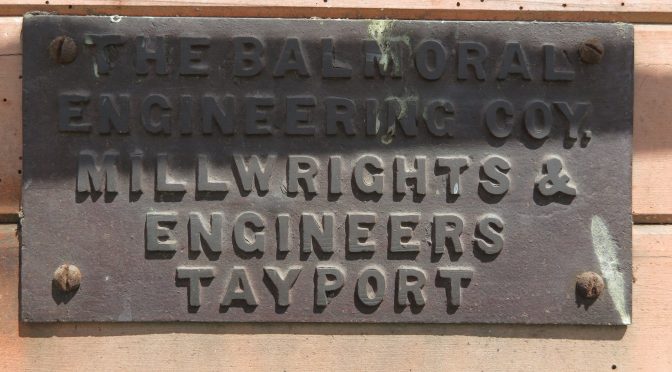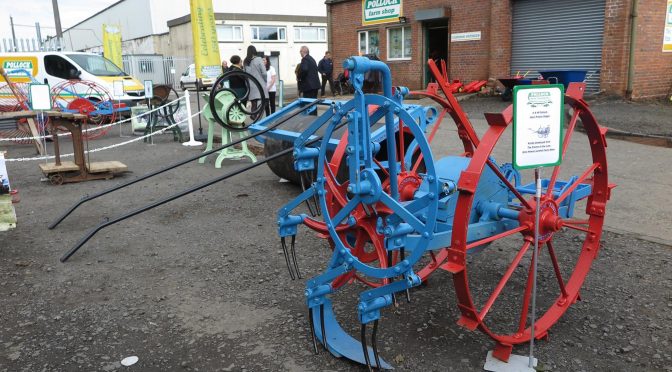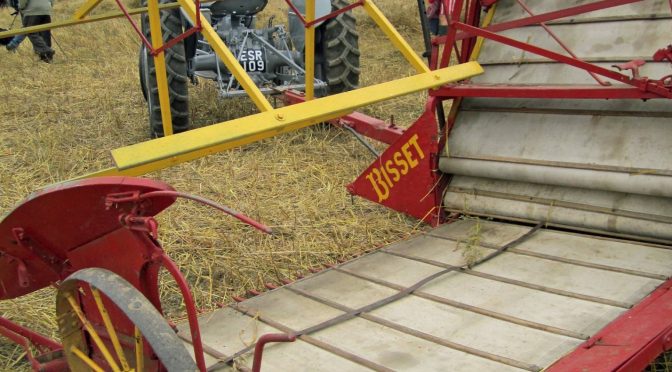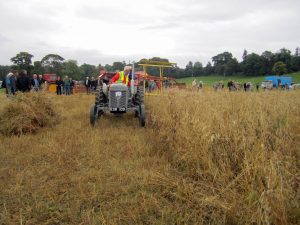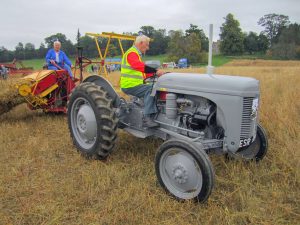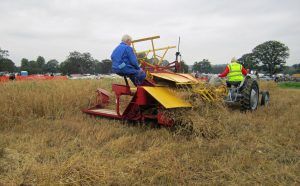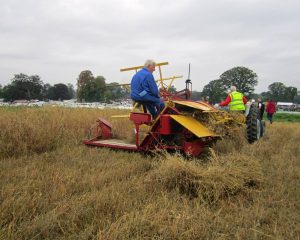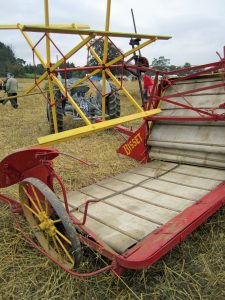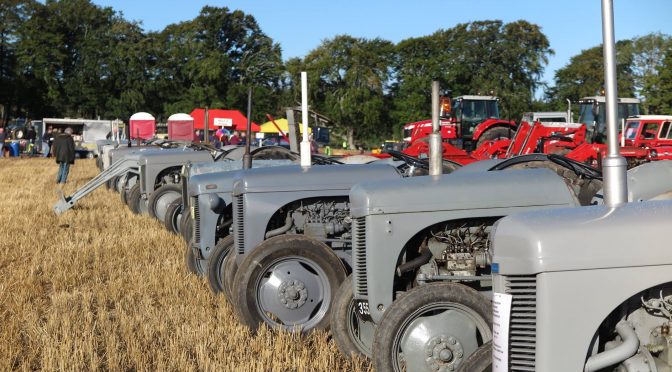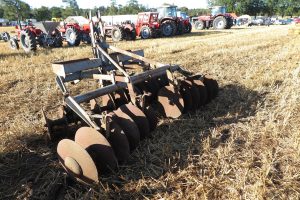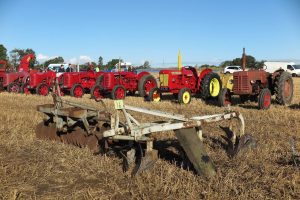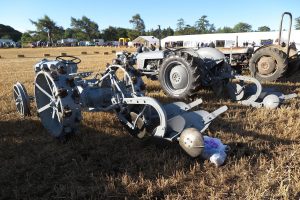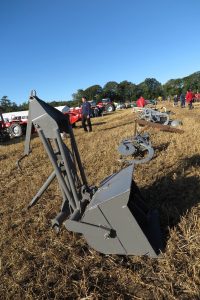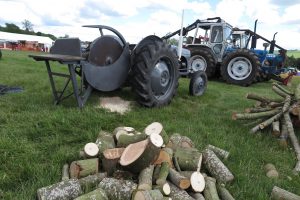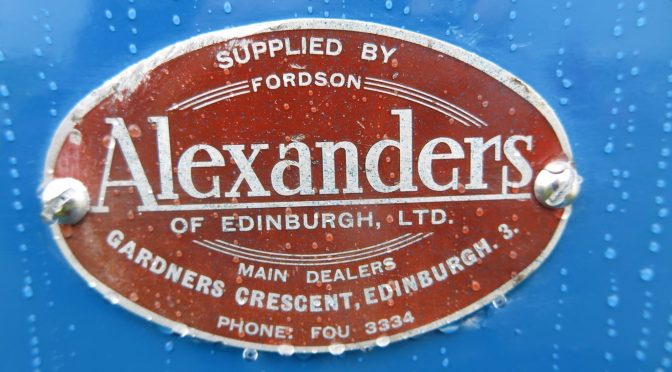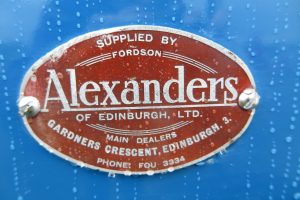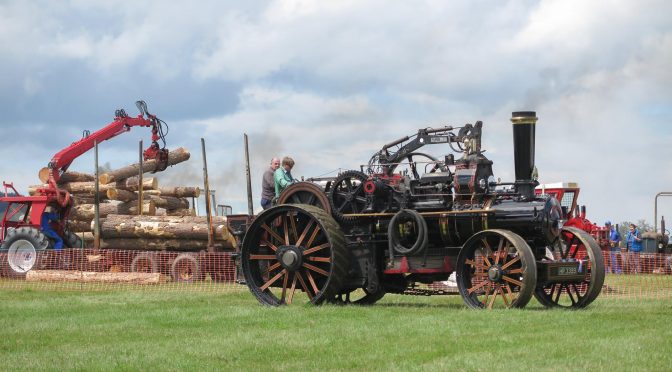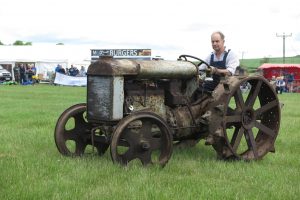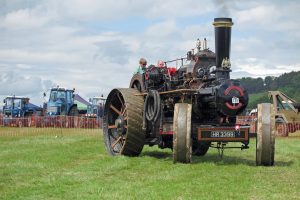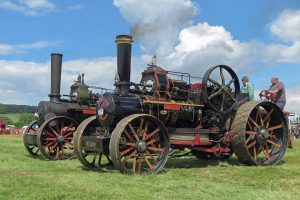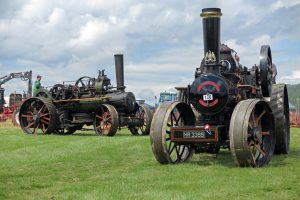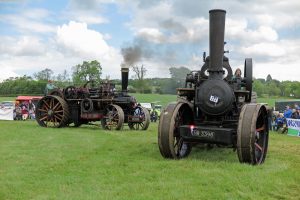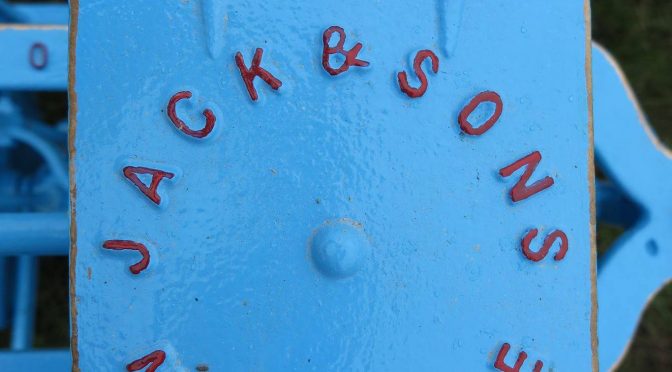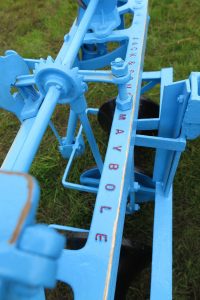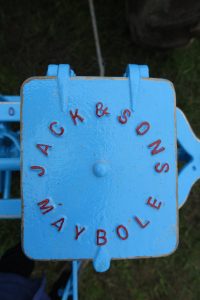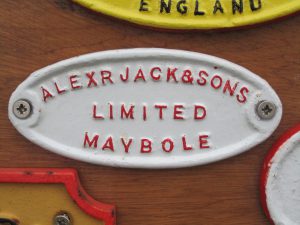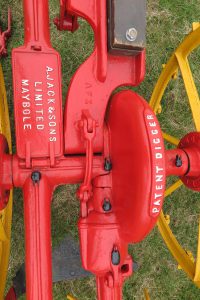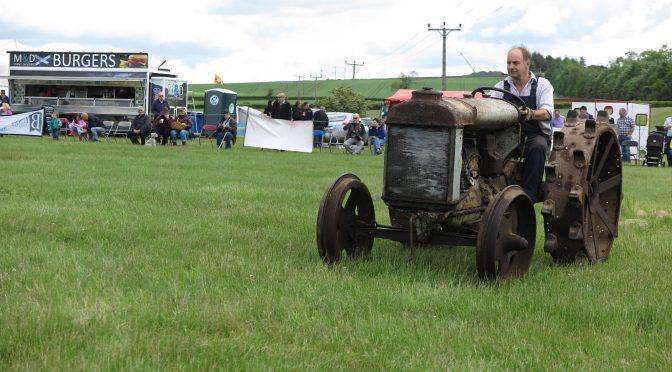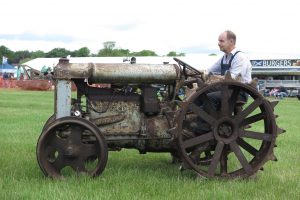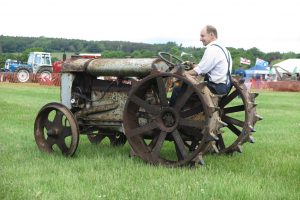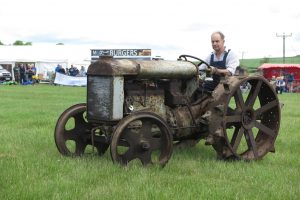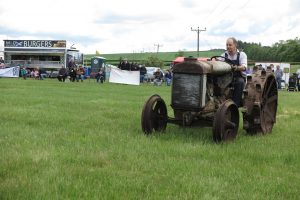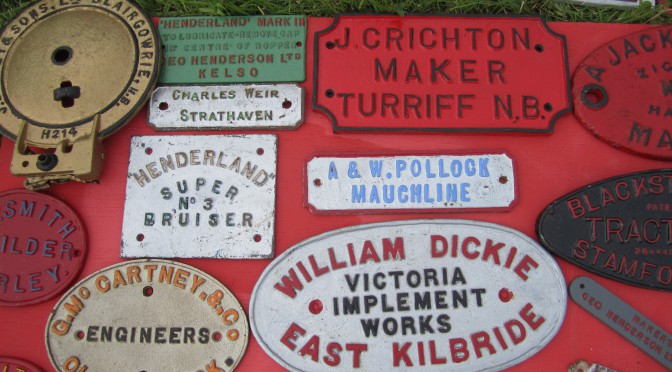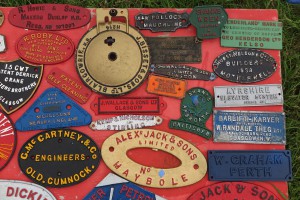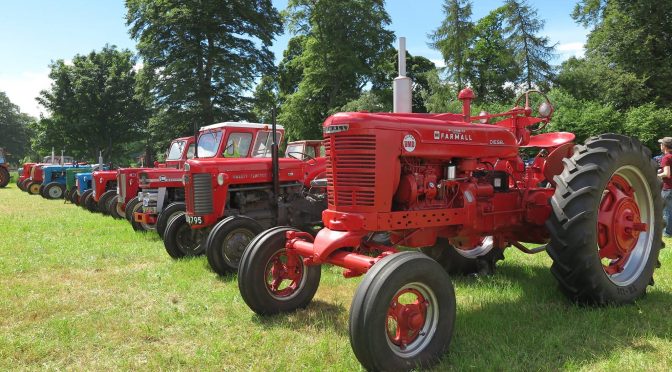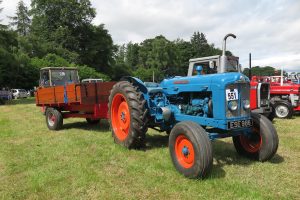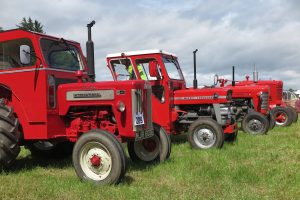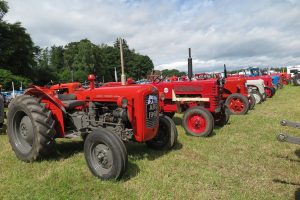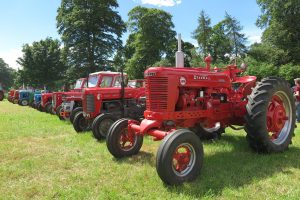14 August 2017 marks 50 years to the day that Jimmy McGhee of Pollock Farm Equipment started his apprenticeship agreement with A. & W. Pollock, Mauchline. Its quite an achievement to be in a trade for half a century! Jimmy writes of his experiences and the company’s history in his book Pollock: Agricultural Implement Makers 1867-2017 (which can be obtained through Pollock Farm Equipment Ltd or Carn Publishing). (see http://www.pollockfarmequip.co.uk or http://www.carnpublishing.com)
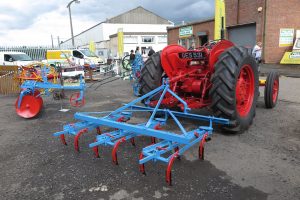 Jimmy is one of a small number of agricultural implement makers who have worked in the Scottish implement and machine industry in the twentieth century. Another was Wm Poole JP, who reached that celebration in October 1922. Poole was of the firm of Armstrong & Main, Edinburgh, later A. & J. Main & Co Ltd, whose name is usually associated with farm buildings, especially hay sheds.
Jimmy is one of a small number of agricultural implement makers who have worked in the Scottish implement and machine industry in the twentieth century. Another was Wm Poole JP, who reached that celebration in October 1922. Poole was of the firm of Armstrong & Main, Edinburgh, later A. & J. Main & Co Ltd, whose name is usually associated with farm buildings, especially hay sheds.
The implement trade had a dinner and celebration to commemorate William’s achievement. The North British Agriculturist carried an extensive piece on that dinner and celebration. It highlights the relationships between the members of the trade and aspects of their businesses. It is worth quoting t length in providing a window on the Scottish agricultural implement and machinery trade in 1922:
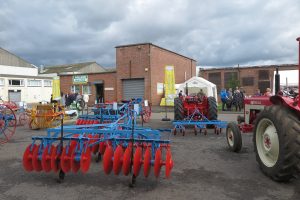 “A particularly pleasing and happy function took place in Messrs Ferguson & Forresters’ Restaurant, Princes Street, Edinburgh, on Tuesday night, when his many friends in the implement trade and others entertained Councillor William Poole, JP, of the well-known and old-established firm of Messrs Armstrong & Main, agricultural implement makers, Edinburgh, at dinner, and presented him with an illuminated address and other handsome gifts, in honour of his jubilee in the agricultural implement trade. A company of about 70 sat down at dinner, presided over by Mr James H. Steele, Edinburgh, who was supported at the chairman’s table by Councillor Poole, Sir Isaac Connell, Secretary of the Scottish Chamber of Agriculture; Bailie A. Thornton Hunter (Messrs A. Jack & Sons Ltd, Maybole); Mr W. B. Wallace (Messrs Wallace (Glasgow) Ltd, Glasgow): Major J. kemp Smith (Messrs Kemp & Nicholson, Stirling); and Mr J. K. McAuslin, CA, Glasgow. The arrangements of the committee, with Mr James H. Steele as convener, and Mr J. K. McAuslin as secretary, were admirable, and the proceedings were of the most successful and gratifying character.
“A particularly pleasing and happy function took place in Messrs Ferguson & Forresters’ Restaurant, Princes Street, Edinburgh, on Tuesday night, when his many friends in the implement trade and others entertained Councillor William Poole, JP, of the well-known and old-established firm of Messrs Armstrong & Main, agricultural implement makers, Edinburgh, at dinner, and presented him with an illuminated address and other handsome gifts, in honour of his jubilee in the agricultural implement trade. A company of about 70 sat down at dinner, presided over by Mr James H. Steele, Edinburgh, who was supported at the chairman’s table by Councillor Poole, Sir Isaac Connell, Secretary of the Scottish Chamber of Agriculture; Bailie A. Thornton Hunter (Messrs A. Jack & Sons Ltd, Maybole); Mr W. B. Wallace (Messrs Wallace (Glasgow) Ltd, Glasgow): Major J. kemp Smith (Messrs Kemp & Nicholson, Stirling); and Mr J. K. McAuslin, CA, Glasgow. The arrangements of the committee, with Mr James H. Steele as convener, and Mr J. K. McAuslin as secretary, were admirable, and the proceedings were of the most successful and gratifying character.
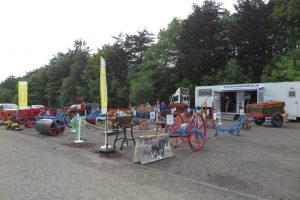 After dinner the Chairman gave the toast of “The King”.
After dinner the Chairman gave the toast of “The King”.
Councillor Watt, Edinburgh, gace “The Imperial Forces”, coupled with the name of Major J, Kemp Smith, who replied.
Mr W. B. Wallace, Glasgow, proposed the toast of “Scottish Agriculture”. He referred to the wide variety of sciences embraced in the practice of agriculture, and remarked that from earliest times right down through the ages it could lay claim to a record of progress. It was quite true that agriculture was at present in a sort of backwash, and it was so more than it should be simply because of the renunciation of solemn pledges by the Government of the day. (hear, hear). All industries, however, had been suffering, but he was confident that there were better days in store for agriculture, because just as it was the earliest of their industries, so they were assured in the Old Book that it would be the last, for they were told that there would come a time when they would beat their swords into ploughshares, and their spears into pruning hooks. (Applause). 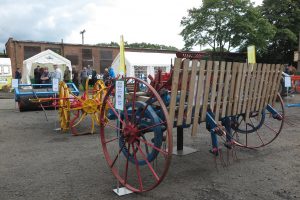 He coupled the toast with the name of Sir Isaac Connell.
He coupled the toast with the name of Sir Isaac Connell.
Sir Isaac Connell in reply said they were still aware that agriculture to-day was not so prosperous as it had been during the war, but they must not allow themselves to be carried away with the great drop that had occurred between prosperity of war times and the mediocre conditions of to-day. The comparison should really be between pre-war and to-day. (Hear, hear). If they looked at it in that way, they would realise that they were not quite so bad after all. It w2as quite true that in England there had been a very large number of bankruptcies amongst farmers, and an insurance official told him that in Scotland more farmers were asking for advances on their insurance policies just now than he could ever remember; but things would brighten up if they looked their difficulties in the face, and they were going to do it. (Applause) They would find that there would be a lot of people spouting about panaceas for agricultural depression, but many of them were visionaries devoid of practical experience, and did to speak with the practical sense which the mover of that motion had done. (Hear, hear). they ere up against a stiff proposition, but they were not going to die down to it. (Applause) It was right that the Government should help, and that they should get assistance, and they ere getting assistance, in various ways. …
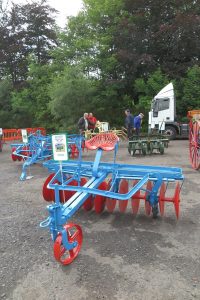 The Secretary then submitted letters of apology for absence from a large number of well-wishers of the guest of the evening, including Sir Hugh Shaw Stewart, Sir David Wilson of Carbeth, Sir Robert Greig, Chairman of the Board of Agriculture for Scotland, Sir Harry Hope, Dr C M Douglas CB, of Auchlochan, and others. Amongst a number of letters read, expressing the kindliest good wishes regarding Mr Poole, was one from Mr James Deering, of Chicago, who offered his heartiest congratulations, and wished the guest of the evening “the greatest possible happiness.”
The Secretary then submitted letters of apology for absence from a large number of well-wishers of the guest of the evening, including Sir Hugh Shaw Stewart, Sir David Wilson of Carbeth, Sir Robert Greig, Chairman of the Board of Agriculture for Scotland, Sir Harry Hope, Dr C M Douglas CB, of Auchlochan, and others. Amongst a number of letters read, expressing the kindliest good wishes regarding Mr Poole, was one from Mr James Deering, of Chicago, who offered his heartiest congratulations, and wished the guest of the evening “the greatest possible happiness.”
Bailie Thornton Hunter, Maybole, then proceeded to make the presentation to Mr Poole, and to submit the toast of his health. He saw that the North British Agriculturist described Mr Poole as the “Father of the Scottish agricultural implement trade”. That title was quite correct, but it did seem to him a rather patriarchal cognomen for such a comparatively young-looking man as Mr Poole-(applause)-and judging from Mr Poole’s physical appearance, it looked as if he 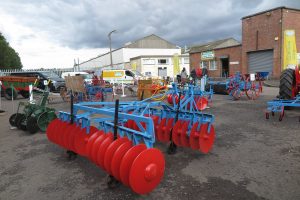 would remain in undisputed possession of the title for many a day to come, as he was sure it was the wish of his many friends in the trade that it might be. (Applause). Fifty years was a large slice of a man’s life, and he was sure Mr Poole could entertain his friends if he were to review in retrospect some of the many figures he had seen strutting on the agricultural implement trade stage in his time. he doubted, however, if Mr Poole, with his long experience, could point to any agricultural implement maker-in Scotland, at any rate-who made a fortune out of the trade. (Hear, hear). They would agree with him that while they had made some grand implements-none better were produced anywhere than in Scotland-(hear, hear)-they hadna made buckle silver. (Laughter). he often wondered whether the agricultural engineer got the credit he
would remain in undisputed possession of the title for many a day to come, as he was sure it was the wish of his many friends in the trade that it might be. (Applause). Fifty years was a large slice of a man’s life, and he was sure Mr Poole could entertain his friends if he were to review in retrospect some of the many figures he had seen strutting on the agricultural implement trade stage in his time. he doubted, however, if Mr Poole, with his long experience, could point to any agricultural implement maker-in Scotland, at any rate-who made a fortune out of the trade. (Hear, hear). They would agree with him that while they had made some grand implements-none better were produced anywhere than in Scotland-(hear, hear)-they hadna made buckle silver. (Laughter). he often wondered whether the agricultural engineer got the credit he 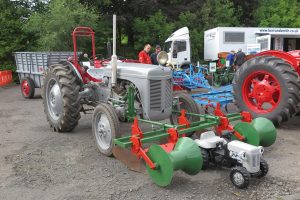 was entitled to for inventing and improving machinery to assist the farmer in his endeavour to make the proverbial two blades of grass grow where only one grew before, but they would agree with him when he said that one of the men in the trade who deserved a share in that credit was their guest, particularly in connection with the development and improvement of the self-binder. (Applause) Bailie Hunter concisely reviewed Mr Poole’s association with the introduction and improvement of the Ransomes’ double-furrow plough, the single-furrow chilled plough and dragging ploughs, the various types of mowers and reapers, and said that Me Poole’s connection with the introduction into this country of the self-binder was a unique and interesting one. He recalled that in August 1878, at a field trial of the Walter A. Wood, and the McCormick wire binders, he superintended and secured for his firm a gold medal for the McCormick machine-(applause)-and in the early ‘eighties he had the honour of starting the first twine binder ever put to work in Scotland. (Applause) It would be
was entitled to for inventing and improving machinery to assist the farmer in his endeavour to make the proverbial two blades of grass grow where only one grew before, but they would agree with him when he said that one of the men in the trade who deserved a share in that credit was their guest, particularly in connection with the development and improvement of the self-binder. (Applause) Bailie Hunter concisely reviewed Mr Poole’s association with the introduction and improvement of the Ransomes’ double-furrow plough, the single-furrow chilled plough and dragging ploughs, the various types of mowers and reapers, and said that Me Poole’s connection with the introduction into this country of the self-binder was a unique and interesting one. He recalled that in August 1878, at a field trial of the Walter A. Wood, and the McCormick wire binders, he superintended and secured for his firm a gold medal for the McCormick machine-(applause)-and in the early ‘eighties he had the honour of starting the first twine binder ever put to work in Scotland. (Applause) It would be  conceded that Mr Poole had contributed in no small measure to the art of agricultural implement making-particularly to the self-binder branch of the art-and that a debt of gratitude was due to him by the whole agricultural community for his energy, ability, and enterprise. (Applause) He was a advocate, as they knew, of co-operation in the interests of the implement trade. On numerous occasions he had represented with effect the Scottish implement trade at the meetings of the English Trade Association. (Applause) One of the things he might mention in passing was the continued high charges for space at the shows. He just wondered whether if Mr poole, who was a director of the Highland Society, could induce his fellow-directors to give some relief to the trade in this direction. He had helped them before, and he must help again. It was quite true that a concession as given for the Dumfries Show, after pressure by the Implement Dealers’ Association, but it was time they were getting back to something like the pre-war rates. (Applause) The Chairman made complimentary reference to their guest’s useful work on the Edinburgh Town
conceded that Mr Poole had contributed in no small measure to the art of agricultural implement making-particularly to the self-binder branch of the art-and that a debt of gratitude was due to him by the whole agricultural community for his energy, ability, and enterprise. (Applause) He was a advocate, as they knew, of co-operation in the interests of the implement trade. On numerous occasions he had represented with effect the Scottish implement trade at the meetings of the English Trade Association. (Applause) One of the things he might mention in passing was the continued high charges for space at the shows. He just wondered whether if Mr poole, who was a director of the Highland Society, could induce his fellow-directors to give some relief to the trade in this direction. He had helped them before, and he must help again. It was quite true that a concession as given for the Dumfries Show, after pressure by the Implement Dealers’ Association, but it was time they were getting back to something like the pre-war rates. (Applause) The Chairman made complimentary reference to their guest’s useful work on the Edinburgh Town 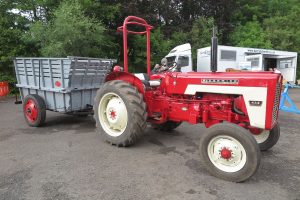 Council, and remarked that Mr Poole’s imagination and capacity for getting things done had stood him in good stead. (Applause) He had also genius for making friends, which was also a most valuable asset. (Applause) the Chairman concluded by presenting Mr Poole on behalf of the subscribers to that testimonial-with an illuminated address,a nd expressed the hope that it might long adorn the wall of the best room in his house. (Applause)
Council, and remarked that Mr Poole’s imagination and capacity for getting things done had stood him in good stead. (Applause) He had also genius for making friends, which was also a most valuable asset. (Applause) the Chairman concluded by presenting Mr Poole on behalf of the subscribers to that testimonial-with an illuminated address,a nd expressed the hope that it might long adorn the wall of the best room in his house. (Applause)
The address, which was an artistic example of the engraver’s art, set in a handsome frame, gave expression to the subscribers’ appreciation of Mr Poole’s long and successful career in the implement trade, his useful work as a Town Councillor of the City of Edinburgh, and their heartiest good wishes for his continued health and happiness.
Continuing, the Chairman said he had also the pleasure of handing over to Mr Poole that gold watch. Inscribed on an old sundial were the words “I mark only shining hours”. (Applause) If was his wish, and the wish of them all present, that all the hours recorded by that watch should be bright and shining hours for him and his, and as often as he looked at its beautiful face they hoped there would be reflected back to him the esteem, regard, and affection of their many friends in the implement trade in Scotland and furth of it. (Applause) He was glad to know that the Committee had not forgotten Mr Poole’s daughter,a nd it was his further pleasing duty to ask Mr Poole to accpt on her behalf that piece of jewellery as a memento to mark that auspicious occasion in her father’s life, and they hoped that they might both be long spared to each other.
Mr Poole’s health was honoured with much enthusiasm and the singing of “He’s a jolly good fellow.”
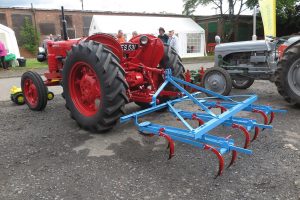 Councillor Poole, who on rising to reply was received with hearty applause, said it was difficult for him to speak that night for emotions that were stirring within him through the many kind thoughts that had been expressed about him by absent friends overseas and in distant parts of the country, and by those present who were honouring him with their presence there. They would therefore pardon him of his words were halting. It was his good fortune in 1872, through the instrumentality of the late Mr James A. R. Main, the founder of the firm of A. & J. Main & Co., to become acquainted with the agricultural machinery business. From that time to the present, the just and kindly treatment he had received from his successors, namely his son, Mr J. A. Main; his nephew, Mr Robert Ramsay Main, who was now in retirement at Crieff; and from Mr George R. Main, who had had very considerable business experience both in India and at home, accounted for his still being connected with the firm. (Applause) had time permitted, he would have described the personality and the important work of
Councillor Poole, who on rising to reply was received with hearty applause, said it was difficult for him to speak that night for emotions that were stirring within him through the many kind thoughts that had been expressed about him by absent friends overseas and in distant parts of the country, and by those present who were honouring him with their presence there. They would therefore pardon him of his words were halting. It was his good fortune in 1872, through the instrumentality of the late Mr James A. R. Main, the founder of the firm of A. & J. Main & Co., to become acquainted with the agricultural machinery business. From that time to the present, the just and kindly treatment he had received from his successors, namely his son, Mr J. A. Main; his nephew, Mr Robert Ramsay Main, who was now in retirement at Crieff; and from Mr George R. Main, who had had very considerable business experience both in India and at home, accounted for his still being connected with the firm. (Applause) had time permitted, he would have described the personality and the important work of 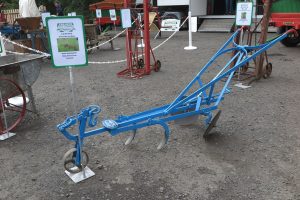 several of his contemporaries-very dear friends who had passed over to the majority, and through whose inventions the agriculturists have been able to build up their important industry to the high level it now occupies. (Applause) The manufacture of agricultural machinery in this country had been looked upon by many as the condoler of the engineering profession, but in his opinion this was a mis-conception. In the great countries of the United States, Canada, Australia, New Zealand, Argentine, and South Africa, the agricultural engineer occupied a position of pre-eminence, and in co-operation with the farmer had helped forward the development of these new countries with a rapidity that otherwise would have been impossible. He made bold to say, so far as his knowledge was concerned, that no description of heavy engineering work had ever been so profitable to the manufacturer as the manufacture of agricultural machinery throughout the United States, and in this connection he would cite the name of William peering, of harvesting machine fame, who started business with a moderate amount of capital, and who, according to report, left a fortune of twenty million sterling; also James Oliver, a Scotsman, of chill plough fame, who was stated to have left a fortune of ten million sterling. (Applause)
several of his contemporaries-very dear friends who had passed over to the majority, and through whose inventions the agriculturists have been able to build up their important industry to the high level it now occupies. (Applause) The manufacture of agricultural machinery in this country had been looked upon by many as the condoler of the engineering profession, but in his opinion this was a mis-conception. In the great countries of the United States, Canada, Australia, New Zealand, Argentine, and South Africa, the agricultural engineer occupied a position of pre-eminence, and in co-operation with the farmer had helped forward the development of these new countries with a rapidity that otherwise would have been impossible. He made bold to say, so far as his knowledge was concerned, that no description of heavy engineering work had ever been so profitable to the manufacturer as the manufacture of agricultural machinery throughout the United States, and in this connection he would cite the name of William peering, of harvesting machine fame, who started business with a moderate amount of capital, and who, according to report, left a fortune of twenty million sterling; also James Oliver, a Scotsman, of chill plough fame, who was stated to have left a fortune of ten million sterling. (Applause)
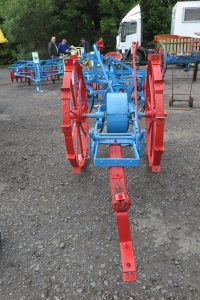 During the late war the British Government discovered the importance of the agricultural engineer, and the amount of work entrusted to him through the manufacture of munitions of war and specialities connected with the same was simply stupendous. And it must not eb forgotten that it was in an agricultural engineerings hop at Lincoln that the first War Tank was designed and built. (Applause) As a lad he (Mr Poole) was brought into contact with the late Mr George Greig, a Scotsman, of the firm of J. Fowler & Sons, Leeds. the agricultural engineer, through the enterprise and expenditure of vast sums of money by the then Duke of Sutherland, a truly noble Scottish patriot who had the welfare of our country and the interests of the farmer at heart-(applause)-carried through successfully the greatest and most important scheme of land reclamation and development in Great Britain that had ever taken place in our time; but, alas! through the lack of sunshine, this great effort did not meet with the success which it deserved. For this County of Sutherland scheme, Mr Greig and his firm designed special steam ploughs, cultivators, &c which were necessary for that important work. (Applause) Following up the patriotic and valued services of the Duke of Sutherland, he would call to their recollection the valuable assistance which the Scottish agricultural engineer had always received from the Scottish landed proprietor, his factors, and his agents, and he would say with emphasis that their passing at the present time was nothing short of a national calamity. (Hear, hear)
During the late war the British Government discovered the importance of the agricultural engineer, and the amount of work entrusted to him through the manufacture of munitions of war and specialities connected with the same was simply stupendous. And it must not eb forgotten that it was in an agricultural engineerings hop at Lincoln that the first War Tank was designed and built. (Applause) As a lad he (Mr Poole) was brought into contact with the late Mr George Greig, a Scotsman, of the firm of J. Fowler & Sons, Leeds. the agricultural engineer, through the enterprise and expenditure of vast sums of money by the then Duke of Sutherland, a truly noble Scottish patriot who had the welfare of our country and the interests of the farmer at heart-(applause)-carried through successfully the greatest and most important scheme of land reclamation and development in Great Britain that had ever taken place in our time; but, alas! through the lack of sunshine, this great effort did not meet with the success which it deserved. For this County of Sutherland scheme, Mr Greig and his firm designed special steam ploughs, cultivators, &c which were necessary for that important work. (Applause) Following up the patriotic and valued services of the Duke of Sutherland, he would call to their recollection the valuable assistance which the Scottish agricultural engineer had always received from the Scottish landed proprietor, his factors, and his agents, and he would say with emphasis that their passing at the present time was nothing short of a national calamity. (Hear, hear)
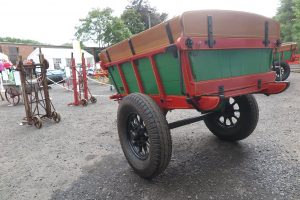 He had been connected with their important national institution, the Highland and Agricultural Society of Scotland, since the year 1873. With few exceptions he had been present at the many trials and competitions that have been held under the auspices of the Society, and he had no hesitation in saying that the trials of tractors and tractor implements recently held at Dalkeith were, in his opinion, the most valuable and successful, so far as good and satisfactory work was concerned that the Society had ever held. (Applause) He recalled with pleasure the kindly personality of former secretaries-the late F. N. Menzies, who during the Show week used to ride about the show ground on his pony, with an imposing and majestic appearance; also Mr James MacDonald, one of the ablest and best informed men regarding the progress and development of every feature of Scottish agriculture, and in connection with the establishemnt of small holdings, and the prosperity of our Scottish crofters, he, in his (the speaker’s) opinion, was the most accurate judge of the whole situation when he told him that if the agriculturists of Scotland, small and great, were to be placed into a position that would enable them to obtain a just return for their expenditure and labours, the only course to follow out to attain this would be that our Government should impose a tariff on agricultural products, the same as that which the French Government had imposed, and which had brought prosperity to the farmers of their country. …
He had been connected with their important national institution, the Highland and Agricultural Society of Scotland, since the year 1873. With few exceptions he had been present at the many trials and competitions that have been held under the auspices of the Society, and he had no hesitation in saying that the trials of tractors and tractor implements recently held at Dalkeith were, in his opinion, the most valuable and successful, so far as good and satisfactory work was concerned that the Society had ever held. (Applause) He recalled with pleasure the kindly personality of former secretaries-the late F. N. Menzies, who during the Show week used to ride about the show ground on his pony, with an imposing and majestic appearance; also Mr James MacDonald, one of the ablest and best informed men regarding the progress and development of every feature of Scottish agriculture, and in connection with the establishemnt of small holdings, and the prosperity of our Scottish crofters, he, in his (the speaker’s) opinion, was the most accurate judge of the whole situation when he told him that if the agriculturists of Scotland, small and great, were to be placed into a position that would enable them to obtain a just return for their expenditure and labours, the only course to follow out to attain this would be that our Government should impose a tariff on agricultural products, the same as that which the French Government had imposed, and which had brought prosperity to the farmers of their country. …
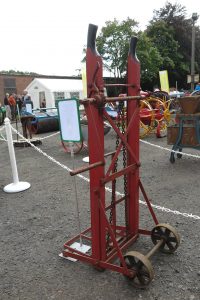 Mr Robert K. Anderson, proprietor of the North British Agriculturist, submitted the toast of “Our Scottish Capital and its Civic Rulers”. He said that it was only proper, in a gathering like that, when the gentleman they were met to honour was himself a Town Councillor, that they cshould remember his co-workers in the municipal affairs of Edinburgh. (Applause) Looking back over thirty or forty years, as their guest did that night, it was a matter of satisfaction to know that many members of the engineering trade were not so entirely engrossed in their own business as not to be able to devote some measure of their time to the important work of municipal affairs. (Applause) He might remark that they had a good example of this in their friend Bailie Hunter, who made the presentation. (Applause) Although their friend, Mr Poole, had entered the Town Council somewhat late in life, he had, notwithstanding, proved himself a most useful member, owing, no doubt, to the fact that he was a practical man, and endowed with a liberal measure of that quality known as common sense. (Applause) …
Mr Robert K. Anderson, proprietor of the North British Agriculturist, submitted the toast of “Our Scottish Capital and its Civic Rulers”. He said that it was only proper, in a gathering like that, when the gentleman they were met to honour was himself a Town Councillor, that they cshould remember his co-workers in the municipal affairs of Edinburgh. (Applause) Looking back over thirty or forty years, as their guest did that night, it was a matter of satisfaction to know that many members of the engineering trade were not so entirely engrossed in their own business as not to be able to devote some measure of their time to the important work of municipal affairs. (Applause) He might remark that they had a good example of this in their friend Bailie Hunter, who made the presentation. (Applause) Although their friend, Mr Poole, had entered the Town Council somewhat late in life, he had, notwithstanding, proved himself a most useful member, owing, no doubt, to the fact that he was a practical man, and endowed with a liberal measure of that quality known as common sense. (Applause) …
The proceedings were pleasantly varied by songs and stories, contributed by various members of the company.
The photographs were taken at Pollock Farm Equipment 150th anniversary celebrations at the company’s works, 12 August 2017.
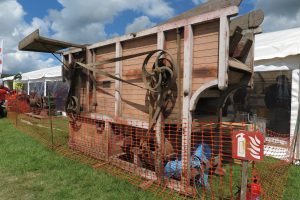 It isn’t often that we feature articles of mills makers from Fife. But there were a number of mill makers in Fife. In the early 1920s one of them was the Balmoral Engineering Works Co., Nelson Street, Tayport. The business exhibited at the Highland Show at Perth in 1924, where it had 4 exhibits.
It isn’t often that we feature articles of mills makers from Fife. But there were a number of mill makers in Fife. In the early 1920s one of them was the Balmoral Engineering Works Co., Nelson Street, Tayport. The business exhibited at the Highland Show at Perth in 1924, where it had 4 exhibits.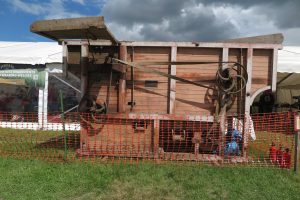 The Balmoral mill at the Fife Vintage Agricultural Machinery Rally, June 2017, appears to date from around the 1920s, if not before then. It makes for an interesting story in the agricultural implement and machine makers: of businesses that were short-lived, also moving around the country, wives managing businesses, and family run businesses.
The Balmoral mill at the Fife Vintage Agricultural Machinery Rally, June 2017, appears to date from around the 1920s, if not before then. It makes for an interesting story in the agricultural implement and machine makers: of businesses that were short-lived, also moving around the country, wives managing businesses, and family run businesses.